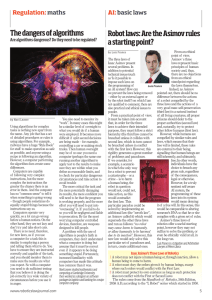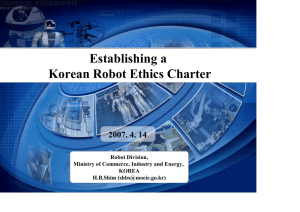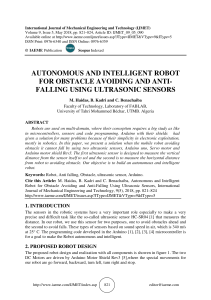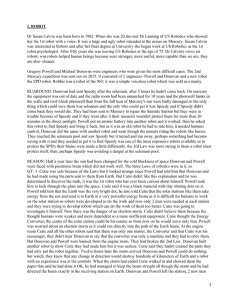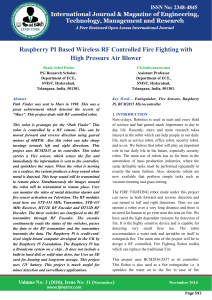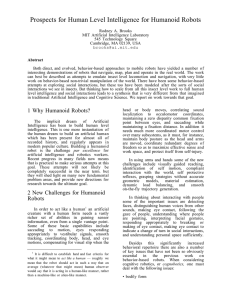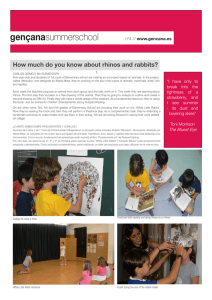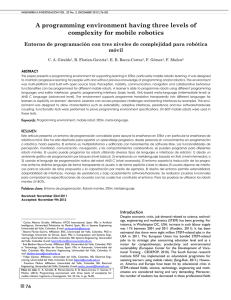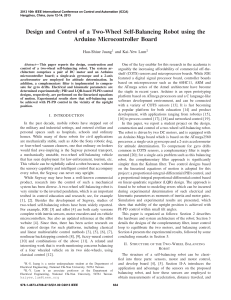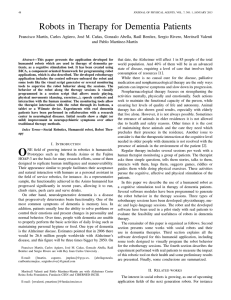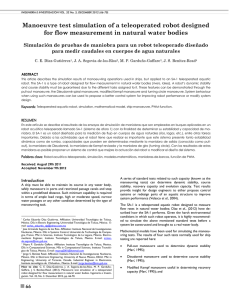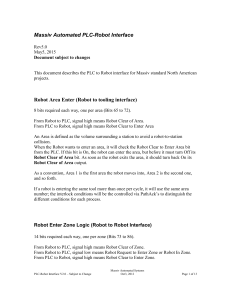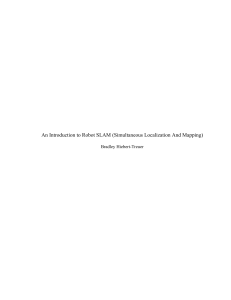Design of an optimal control for an autonomous mobile robot
Anuncio
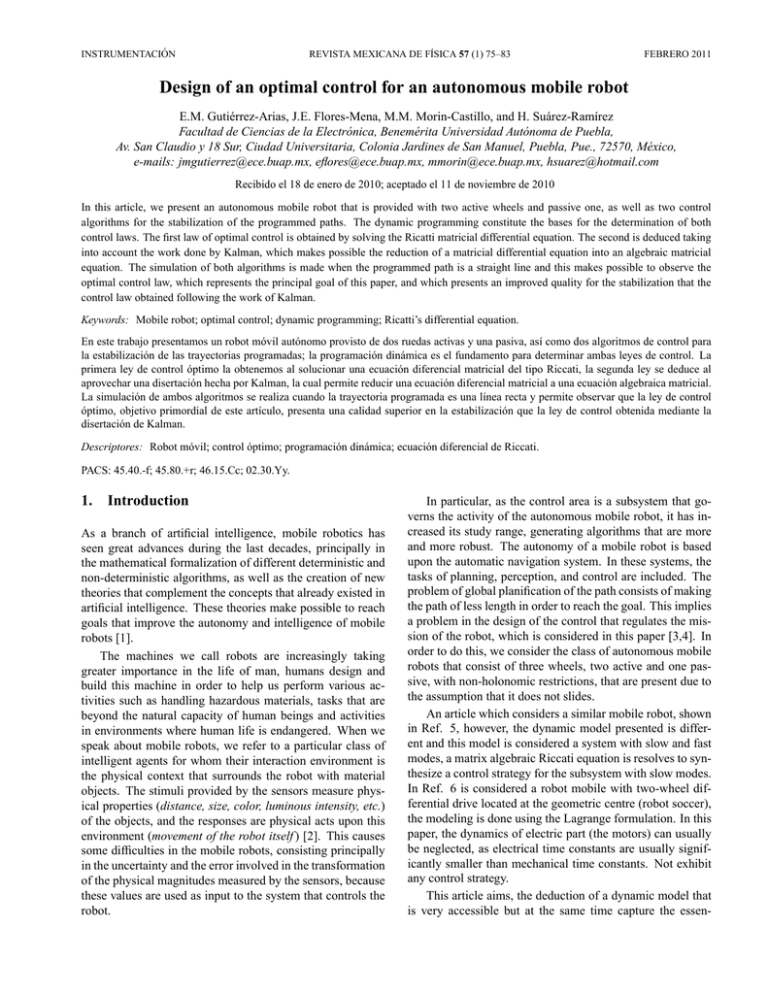
INSTRUMENTACIÓN REVISTA MEXICANA DE FÍSICA 57 (1) 75–83 FEBRERO 2011 Design of an optimal control for an autonomous mobile robot E.M. Gutiérrez-Arias, J.E. Flores-Mena, M.M. Morin-Castillo, and H. Suárez-Ramı́rez Facultad de Ciencias de la Electrónica, Benemérita Universidad Autónoma de Puebla, Av. San Claudio y 18 Sur, Ciudad Universitaria, Colonia Jardines de San Manuel, Puebla, Pue., 72570, México, e-mails: [email protected], [email protected], [email protected], [email protected] Recibido el 18 de enero de 2010; aceptado el 11 de noviembre de 2010 In this article, we present an autonomous mobile robot that is provided with two active wheels and passive one, as well as two control algorithms for the stabilization of the programmed paths. The dynamic programming constitute the bases for the determination of both control laws. The first law of optimal control is obtained by solving the Ricatti matricial differential equation. The second is deduced taking into account the work done by Kalman, which makes possible the reduction of a matricial differential equation into an algebraic matricial equation. The simulation of both algorithms is made when the programmed path is a straight line and this makes possible to observe the optimal control law, which represents the principal goal of this paper, and which presents an improved quality for the stabilization that the control law obtained following the work of Kalman. Keywords: Mobile robot; optimal control; dynamic programming; Ricatti’s differential equation. En este trabajo presentamos un robot móvil autónomo provisto de dos ruedas activas y una pasiva, ası́ como dos algoritmos de control para la estabilización de las trayectorias programadas; la programación dinámica es el fundamento para determinar ambas leyes de control. La primera ley de control óptimo la obtenemos al solucionar una ecuación diferencial matricial del tipo Riccati, la segunda ley se deduce al aprovechar una disertación hecha por Kalman, la cual permite reducir una ecuación diferencial matricial a una ecuación algebraica matricial. La simulación de ambos algoritmos se realiza cuando la trayectoria programada es una lı́nea recta y permite observar que la ley de control óptimo, objetivo primordial de este artı́culo, presenta una calidad superior en la estabilización que la ley de control obtenida mediante la disertación de Kalman. Descriptores: Robot móvil; control óptimo; programación dinámica; ecuación diferencial de Riccati. PACS: 45.40.-f; 45.80.+r; 46.15.Cc; 02.30.Yy. 1. Introduction As a branch of artificial intelligence, mobile robotics has seen great advances during the last decades, principally in the mathematical formalization of different deterministic and non-deterministic algorithms, as well as the creation of new theories that complement the concepts that already existed in artificial intelligence. These theories make possible to reach goals that improve the autonomy and intelligence of mobile robots [1]. The machines we call robots are increasingly taking greater importance in the life of man, humans design and build this machine in order to help us perform various activities such as handling hazardous materials, tasks that are beyond the natural capacity of human beings and activities in environments where human life is endangered. When we speak about mobile robots, we refer to a particular class of intelligent agents for whom their interaction environment is the physical context that surrounds the robot with material objects. The stimuli provided by the sensors measure physical properties (distance, size, color, luminous intensity, etc.) of the objects, and the responses are physical acts upon this environment (movement of the robot itself ) [2]. This causes some difficulties in the mobile robots, consisting principally in the uncertainty and the error involved in the transformation of the physical magnitudes measured by the sensors, because these values are used as input to the system that controls the robot. In particular, as the control area is a subsystem that governs the activity of the autonomous mobile robot, it has increased its study range, generating algorithms that are more and more robust. The autonomy of a mobile robot is based upon the automatic navigation system. In these systems, the tasks of planning, perception, and control are included. The problem of global planification of the path consists of making the path of less length in order to reach the goal. This implies a problem in the design of the control that regulates the mission of the robot, which is considered in this paper [3,4]. In order to do this, we consider the class of autonomous mobile robots that consist of three wheels, two active and one passive, with non-holonomic restrictions, that are present due to the assumption that it does not slides. An article which considers a similar mobile robot, shown in Ref. 5, however, the dynamic model presented is different and this model is considered a system with slow and fast modes, a matrix algebraic Riccati equation is resolves to synthesize a control strategy for the subsystem with slow modes. In Ref. 6 is considered a robot mobile with two-wheel differential drive located at the geometric centre (robot soccer), the modeling is done using the Lagrange formulation. In this paper, the dynamics of electric part (the motors) can usually be neglected, as electrical time constants are usually significantly smaller than mechanical time constants. Not exhibit any control strategy. This article aims, the deduction of a dynamic model that is very accessible but at the same time capture the essen- 76 E.M. GUTIÉRREZ-ARIAS, J.E. FLORES-MENA, M.M. MORIN-CASTILLO, AND H. SUÁREZ-RAMÍREZ tial nonlinearities such robots; synthesize two optimal control strategies to plan a robot path, considering a quadratic performance indicator. The first law to get when we solve a Riccati differential matrix equation, the second control law deduced from the previous work done by Kalman. The second control strategy we get it for comparison between the two and show that the strategy obtained by solving the matrix differential equation has a higher quality stabilization. This paper is organized in the following way. Sec. 2 is devoted to the statement of the control problem. In Sec. 3, the mathematical model of the mobile robot is deduced. In Sec. 4, the programmed paths of the mobile robot is described, using the fact that every real path can be achieved as combinations of the programmed paths. In Sec. 5, the linear equations of the state variables are considered for the programmed paths. In Sec. 6 and 7, the first and second control laws are obtained, respectively, as well as the solution algorithms and their simulations. Finally, in Sec. 8, the conclusions obtained are presented. can be written as: ẋ = f̃ (x, t), (3) where f̃ (0, t) ≡ 0 for t ∈ [t0 , t1 ) and x(t0 ) 6= 0. These equations admit a trivial solution that corresponds to the desired movement yd (t) of the system. Let us assume that ud (t) is located inside the Ω set for t ∈ [t0 , t1 ) (this means that there still remain additional resources). For a given control strategy u = ud (t) + ∆u(z̃, t) where ∆u is the additional control. Afterwards, the following linear equations of the deviations are obtained: ẋ = A(t)x + B(t)∆u, (4) where 2. Statement of the Problem A(t) = ∂f [yd (t), ud (t)] , ∂y B(t) = ∂f [yd (t), ud (t)] , ∂u (5) and the linear model of measurement is Let us consider the following controllable process: ½ ẏ = f (y, u), u(·) ∈ U = {u : u(t) ∈ Ω ⊆ Rr } , z̃ = H(t)x detH 6= 0, (1) where y is the nth-dimensional vector that contains the state coordinates of the system, u is the rth-dimensional vector that represents the input controls and f (y, u) belongs to the C 2 class. The control is a vectorial function that is piecewise continuous, and which for every instant of time, it takes its values from the convex, closed, and bounded Ω set. Let us assume that given some displacement yd (t) and a desired control ud (t), the following equations are satisfied: ½ ẏd ≡ f (yd (t), ud (t)), u(.) ∈ U t ∈ [t0 , t1 ). (2) where H(t) = ∂ϕ[(yd (t)] . ∂y • ∆u = u − ud is the additional control, • x = y−yd is the deviation respect to the desired movement, • z̃ = ϕ(y) − ϕ(yd ) is the information vector that is received concerning the deviation. The differential equations that govern the deviations u(t) = ud (t), [t0 , t1 ) (7) Let us suppose that the perturbations upon the system and the measurement errors are null. Almost without exception, there are initial perturbations that are present x(t0 ) 6= 0 and there is only a small number of cases in which for ∆u ≡ 0, the condition x(t) → 0 if t → ∞. Nevertheless, it is much more probable to have the case in which for ∆u ≡ 0, the condition x(t) 9 0 if t → ∞ is satisfied. This results into the stabilization problem; that is, with the use of the information of the desired path, we have to de- Let there be m sensors that produce data about the actual movement. After the processing of this data, it is possible to make an estimate of the actual deviations x(t) = y(t)−yd (t) and to form the control of the actor. Let us use the following notation: x(t)=y(t)−yd (t) for (6) F IGURE 1. Autonomous Mobile Robot. Rev. Mex. Fı́s. 57 (1) (2011) 75–83 DESIGN OF AN OPTIMAL CONTROL FOR AN AUTONOMOUS MOBILE ROBOT FR = M acm 77 (8) and dLcm , (9) dt where FR is the resultant force upon the mass M of the body and acm is the acceleration of the mass center. On the other hand, in Eq. (9) τ R is the sum of external pairs and Lcm is the angular momentum around the axis that crosses the mass center. Both of the equations are valid in an inertial system which is assumed to be fixed on a flat surface upon which the mobile robot, which is indicated by the X10 , X20 y X30 axes. Moreover, we consider a reference system that is fixed to the robot’s body, whose axes are denoted by X1M , X2M y X3M , and which are shown in Fig. 2. Let C be a point that lies along the X1M axis, and is located at a distance c, with a position vector rc , which will be represented as rc = (x0c1 , x0c2 , x0c3 )T , and where the superindex states that the vector is expressed in the representation of the inertial reference system. The representation of the vector rc in the reference system that is fixed to the body M T M has components (xM 1c , x2c , x3c ) . There is a very useful equation that shows the relationship of the temporal variations that are measured in the two reference systems, on inertial and the other fixed on the moving body (which is denoted with an asterisk), which is dB d∗ B = + ω × B, (10) dt dt where ω is the angular velocity of the fixed system respect to the inertial system. Considering the point C with position vector rc = R + C, where R = (x01 , x02 , x03 )T is the vector that goes from the origin of the inertial reference system to the origin of the reference system that is fixed to the body and C = (c01 , c02 , c03 )T is the vector that goes from the origin of the reference system fixed to the body up to the point C, using the Eq. (10), then the velocity of the point C is given by 0 ẋc1 v cos θ − ωc sin θ ẋ0c2 = −v sin θ + ωc cos θ , (11) ẋ0c3 0 p where v = (ẋ01 )2 + (ẋ02 )2 and θ̇ = ω is the translation velocity of the origin of the mobile reference system and the angular velocity around the X30 axis, respectively. The velocities of the centers of the wheels are obtained by using the Eq. (10), so for the left and right wheels, we obtain M M ẋl1 ẋ1 − aω = , ẋM ẋM (12) 2 l2 M 0 ẋl3 τR = F IGURE 2. Diagram of the mobile robot. termine a control ∆u(z̃, t) such that the real deviations decrease asymptotically. In this paper, it is assumed that we have the exact and complete information of each one of the coordinates [7]. 3. Dynamic model of the mobile robot The dynamic model of the mobile robot plays an important role in the simulation of the movement, the analysis of the mechanic structure of the prototype, and in the design of the control algorithms [8,9]. The autonomous mobile robot that was constructed, is shown in Fig. 1. As can be seen, the prototype consists of a straight, non-homogeneous cylinder, with two lateral wheels and one smaller that function as the support. The movement of the small wheel is not considered, due to the fact that its mass and size are small when compared to the body of the robot. For the construction of the dynamic model of the mobile robot, we make the following considerations: a) The mobile robot moves upon a plane; b) we suppose that the parts of the mobile robot are rigid bodies; c) the movement of the small wheel of support is not considered, which can be done because the mass and size of the wheel are small in comparison to those of the body of the robot; d) the velocities of the mobile robot are small, so that the viscous friction force can be safely ignored; e) the lateral wheels satisfy the non-slipping condition; and f) the friction between the wheels and the flat surface is such that it satisfies the condition of lateral nonslipping of the wheels. Taking into account these considerations, the mobil robot constructed was modeled using a straight cylinder and two lateral wheels with a straight cylinder form, as can be seen in the Figs. 2 and 3, where the mobile robot model is presented, and which was used to obtain the dynamic model. The formulation employed to construct the dynamic model is the Euler-Newton formulation, which consists of using the following equation [10-12]: and Rev. Mex. Fı́s. 57 (1) (2011) 75–83 M ẋM ẋ1 + aω r1 ẋM = , ẋM r2 2 M ẋr3 0 (13) 78 E.M. GUTIÉRREZ-ARIAS, J.E. FLORES-MENA, M.M. MORIN-CASTILLO, AND H. SUÁREZ-RAMÍREZ respectively. In these expressions, a is the distance that lies between the origin of the system fixed to the body to that of the center of the wheel. These velocities have been calculated from the representation of the reference system that is fixed to the body to keep simple the expression. In order to calculate the acceleration, the Eq. (10) is used, applying it twice in order to obtain the equation of the second derivative. The acceleration of a point C that lies upon the X1M is given by the following equation M M ẍc1 ẍ1 − cθ̇2 ẍM = ẍM + cθ̈ . (14) c2 2 M ẍc3 0 The acceleration of the point C is expressed in the representation of the system fixed to the body. Following the same procedure, the acceleration at the center of the left and right wheels are given by the following equations: M M ẍl1 ẍ1 − aθ̈ = ẍM − aθ̇2 , ẍM (15) l2 2 M ẍl3 0 and M ẍM ẍ1 + aθ̈ r1 = ẍM + aθ̇2 , ẍM r2 2 M ẍr3 0 (17) Vr = rφ˙r , (18) M where Vl = ẋM l1 and Vr = ẋr1 . With the help of these expressions, it is possible to write down the first coordinate of the vectorial equations in the following manner (12), (13) Vl = v − aω, (19) Vr = v + aω, (20) since ẋM 1 = v. The angular accelerations of the wheels of the mobile robot are obtained by differentiating respect to time the Eqs. (19) and (20). Thus, (21) (22) where αl = φ̈l , αr = φ̈r y r is the radius of the wheels. The no-slip lateral condition of the wheels is established by requiring that the following conditions are satisfied: M M ẋM l2 = ẋr2 = ẋ2 = 0. Now, by considering the second component of the expression (24) and taking into account the expression (23), the following equation is obtained: 0 0 ẋM 2 = −ẋ1 sin θ + ẋ2 cos θ = 0, (25) and by differentiating respect to time, then Vl = rφ̇l , 1 M (ẍ − aθ̈), r 1 1 + aθ̈), αr = (ẍM r 1 Moreover, the transformation equations for the velocities of the origin of the fixed reference system to the inertial system, can be written in the following way: 0 M ẋ1 ẋ1 cos θ sin θ 0 ẋM ẋ02 . (24) − sin θ cos θ 0 = 2 M 0 0 1 ẋ03 ẋ3 (16) respectively. Taking into account the constriction relationships, let us assume that the wheels satisfy the rolling and non-slipping conditions. (that no lateral slipping occurs in the wheels). The rolling condition is established using the following equations αl = F IGURE 3. Free-Body Diagram. (23) ẍM 2 = 0. (26) Using the free-body diagram of Fig. 3, it is possible to write for every mobile part of the robot the Eq. (8). For the body of the robot, the Eq. (14) has been used in Eq. (8), where c = −b, so ¶ µ 0 µ M 0 ¶ Fl + Fr ẍ1 + bθ̇2 , (27) = m 0 0 b ẍM Rl + Rr 2 − bθ̈ where mb is the mass of the body of the robot and b is the distance between the system that is fixed on the body up to the robot’s mass center. For the left wheel, it is possible to write the Eq. (8) as µ µ M ¶ 0 ¶ Fl − Fl ẍ1 − aθ̈ = m . (28) 0 wl 2 ẍM Rl − Rl 2 − aθ̇ In this expression, mwl is the mass of the left wheel. Meanwhile, for the right wheel, Eq. (8) can be rewritten as µ ¶ µ M ¶ 0 Fr − Fr ẍ1 + aθ̈ = mwr . (29) 0 2 ẍM Rr − Rr 2 + aθ̇ In this expression, mwr is the mass of the right wheel. Adding the corresponding members of Eqs (27), (28), and (29), then µ ¶ µ ¶ 2 M Fl + Fr mb ẍM 1 + mb bθ̇ + 2mw ẍ1 = , (30) M Rl + Rr mb ẍM 2 − mb bθ̈ + 2mw ẍ2 Rev. Mex. Fı́s. 57 (1) (2011) 75–83 79 DESIGN OF AN OPTIMAL CONTROL FOR AN AUTONOMOUS MOBILE ROBOT where it has been considered that the masses of the wheels are equal, mwl = mwr = mw . In order to finish the dynamic model of the mobile robot, it is necessary to apply the second equation of the EulerNewton formulation to the robot model shown in Figs. 2 and 3. Equation (9), can be rewritten as: τ R = ÎCM dω dvCM · + mrCM × . dt dt (31) In order to obtain the equation that completes the dynamic model of the mobile robot, we employed the same plan that produced the Eqs. (30). Considering the free-body diagram of Fig. 3, and using Eq. (31) for the robot’s body and the two wheels, and adding the corresponding sides of the resultant equations, then a(Fr − Fl ) = (I3c + 2I3w ¢ +2mw a2 + mb b2 θ̈ − mb bẍM 2 . (32) In this expression, I3c is the momentum of inertia along the axis that goes through the mass center, which is the robot’s center, and which is parallel to X3M , while I3w is the momentum of inertia along the axis that goes through the mass center of a wheel and that is parallel to the X3M axis. Therefore, to obtain the relationship between the pairs applied by the engines upon the wheels (τl , τr ) and the traction forces that are produced upon the wheelsP (Fl , Fr ), we apply for each one of the wheels the expression i τi = Iα, where the sum of the applied pairs are those who are responsible to the rolling of the wheel with an angular acceleration α around the rotation axis with a momentum of inertia I. Considering the free-body diagram of Fig. 3 and the angular accelerations of the wheels in the expressions (21) and (22), then · ´¸ 1 I2w ³ M Fl = τl − ẍ1 − aθ̈ , (33) r r · ´¸ 1 I2w ³ M Fr = τr − ẍ1 + aθ̈ , (34) r r where I2w is the momentum of inertia respect to the axis that passes through the axis that connects the two wheels. Substituting the equations (33) and (34), in the first component of the expressions (28) and (32), then µ ¶ 2I2w (τr + τl ) 2 = mb + 2mw + 2 ẍM 1 + mb bθ̇ , (35) r r µ a(τr − τl ) = I3c + mb b2 r ¶ 2a2 2 + 2I3w + 2mw a + 2 I2w θ̈, (36) r respectively. The model of the motor which is being considered is the following one [13]: τi = χui − σ φ̇i , i = l, r, (37) TABLE I. Programmed trajectories of horizontal and vertical lines. Trajectory x0d c1 x0d c2 θd vd ωd 1. horizontal line v 0 t + ξ0 0 0 v0 0 v0 t + ξ0 0 π v0 0 0 v0 t + η 0 π 2 v0 0 0 v0 t + η 0 − π2 v0 0 negative sense 2. horizontal line positive sense 3. vertical line negative sense 4. vertical line positive sense where ui is the potential difference applied to the engine i, φ̇i is the angular velocity at which the engine’s axis i rotates, χ is the ratio that exists between the constant electromotive force and the electric resistance of the engine and σ is the ratio between the counter-electromotive force and the electric resistance. Considering this expression and using (17)-(20), then 2v , r 2aω (τr − τl ) = χ(ur − ul ) − σ . r (τr + τl ) = χ(ur + ul ) − σ (38) (39) Finally, substituting Eqs. (38) and (39) in Eqs. (35) and (36) and by using Eq. (11), but with c = h, and by combining them, we obtain the dynamic model 0 ẋc1 = v cos θ − hω sin θ, ẋ0 = v sin θ + hω cos θ, c2 θ̇ = ω, J1 v̇ = −mb bω 2 − 2σ v + χ (ur + ul ), r r2 J ω̇ = 2a2 σ ω + aχ (u − u ). 2 l r r r2 (40) where J1 = mb + 2mw + 2I2w /r2 and J2 = I3c + 2I3w + 2mw a2 + mb b2 + 2a2 I2w /r2 . The expression of the dynamic model, Eq. (40) is a nonlinear system of five differential equations that have two control variables ur y ul . 4. Programmed Paths The stationary programmed paths yd (t), are determined from a specific activity of the robot, and they are given in such a Rev. Mex. Fı́s. 57 (1) (2011) 75–83 80 E.M. GUTIÉRREZ-ARIAS, J.E. FLORES-MENA, M.M. MORIN-CASTILLO, AND H. SUÁREZ-RAMÍREZ TABLE II. Numerical values of system’s parameters. Variable Value v0 1.5 Description wanted speed, in meters/seconds a 0.40 Distance between wheels, in meters b 0.08 Distance between masses center and the axis of wheels, in meters h 0.10 Distance between the wheels and the array of infrared sensors, in meters F IGURE 4. Training Board of the Mobile Robot way that this activity will be regulated by the desired movement. It is possible to approximate any assigned activity by combinations of horizontal o vertical straight lines and by semicircles. We will make eight possible configurations (as can be seen in Fig. 4). We show the set of desired paths in Table I, where the movement is done along a segment of a line parallel to the (X10 axis or to the X20 axis). In the case in which the robot goes along a horizontal or vertical straight line, as can be seen in Table I, it is assumed that there will be no angular movement (ω d = 0). Those equations that satisfy this set of conditions is said to be in an equilibrium state. If the robot moves along a segment of a circle with diameter R that is centered on one of the corners of the training board, and if we consider this corner and the configuration of the training board, we have four quadrants that are counted counterclockwise, dividing the circle into four equal semicircles. In this situation, it is possible to describe eight possible configurations. Moreover, the set of solutions for the desired path results from considering that the robot describes a semicircular movement, so we assume a constant angular movement. The velocity and the angle are given from this angular displacement, as well as the position coordinates. 5. Linear Equations in the Deviations If ud (t) is a nominal entry to the system that is described by Eqs. (40) and yd (t) is a nominal path of this system, then it is possible to find approximations to the neighboring solutions for small deviations from the initial state and for the entry. Let us suppose that the system is closed for nominal conditions, which implies that u(t) and y(t) will slightly deviate from ud (t) andyd (t). The linear system for the horizontal line in the positive sense is given by: m 4.5 Mass of robot, in kilograms r 0.08 Radius of wheels, in meters 0 ẋc1 = −v, ẋ0c2 = −v0 θ − hω, θ̇ = ω, χ v̇ = − 2σ v + rJ (ur + ul ), 2 1 r J 1 2 aχ 2a σ ω̇ = 2 ω + rJ2 (ur − ul ). r J2 (41) Considering that the desired path is a semicircle, then we obtain the eight systems for the linear deviations, substituting in the following system each one of the desired movements (in this case each system depends on θd ), we present one of these: ¡ ¢ 0 ẋc1 = − v0 sen θd + hω0 cos θd θ + v cos θd − ωh sen θd , ¡ ¢ d d 0 = −v cos θ − hω sen θ θ ẋ 0 0 c2 +v sen θd + ωh cos θd , (42) θ̇ = ω, χ v − 2bωJ0 ωmb + rJ (ur + ul ), v̇ = − 2σ 2 1 1 r J 1 2 aχ ω̇ = 2a2 σ ω + rJ (ur − ul ). 2 r J2 6. First law of optimal control and solution algorithm Considering the system ẋ = Ax(t) + Bu(t), (43) and the stabilization quality functional is given by Z∞ G(x, u) = (xT (t)G(t)x(t) + uT (t)N(t)u(t))dt. (44) 0 Rev. Mex. Fı́s. 57 (1) (2011) 75–83 81 DESIGN OF AN OPTIMAL CONTROL FOR AN AUTONOMOUS MOBILE ROBOT A= 0 0 0 0 0 0 0 0 0 0 B= 0 −1 0 −1.5 0 −0.1 0 0 1 0 0.625 0 0 0 0.3923 0 0 0 0 0 0 0.0278 0 0 0.1744 , (46) . (47) Using the dynamic programming and by considering Bellman’s function, w(x, t) = x(t)L(t)x(t), we obtain Riccatti’s matricial differential equation [14,15]. L̇ = LBBT L − 2AL − G con L(t1 ) = 0. (48) For a given instant t1 , we proceed to solve this system in the inverse time as a system with initial conditions using a variable exchange τ = t − t1 , so that the system (48), which is a non-linear system with final conditions, is transformed to a system with initial conditions. Afterwards, with the use of polynomials, it is possible to obtain an approximation of each one of the matrix elements L(t). Since these functions are written in the inverse time, it is necessary to return to the direct time, obtaining all the matrix elements L(t), and thus, the optimal control is written as u = −N−1 BT L(t)x(t). (49) Finally, we substitute this control into the system ẋ = A(t)x + B(t)u, and by solving for ẋ=(A − BBT L)x, we simulate the behavior of the state variables. F IGURE 5. Diagram of flux to solve the Riccati’s differential matricial equation. The programmed path is considered as a straight line in the negative direction (Table I) x0d c1 x0d c2 θd d v ωd = v0 t + ξ0 0 π v0 . (45) 0 The matrices A, B of the system (43) are obtained according to the values of the parameters of the Table II and are described below: F IGURE 6. Behavior of the state variables when the control considers L(t) Rev. Mex. Fı́s. 57 (1) (2011) 75–83 82 E.M. GUTIÉRREZ-ARIAS, J.E. FLORES-MENA, M.M. MORIN-CASTILLO, AND H. SUÁREZ-RAMÍREZ The diagram of Fig. 3, shows the algorithm that describes the steps that are necessary to obtain the solution. Executing this algorithm in Matlab, the following results of the simulation of the state variables are obtained and shown in Fig. 4. 7. Second law of control and its solution algorithm Kalman states and proves the equivalence between optimal problems [16]. Theorem 7.1 Let us assume that the system ẋ=A(t)x+B(t)u is completely controllable; that is rang(B, AB, ..., An−1 B) = n. If the following problem Zt1 f0 (t) = xT (t0 )L0 (t0 )x(t0 ), min u(·) (50) t0 has a solution of the form u0 (t) = −N−1 BT L(t)x, (51) then in the case in which t1 = ∞ is satisfied, then L(t) → L0 when t → ∞, (52) where LT0 = L0 > 0 and L0 is the solution of the Riccati’s algebraic equation, G − LBN−1 BT L + (LA + AT L) = 0. F IGURE 7. Diagram of flow to solve Riccati’s algebraic matricial equation. (53) Therefore, it is possible to calculate the control as u0 = −N−1 BT L0 x. (54) Thus, we can use Kalman’s result to solve a problem of the type (50) when the control has the form u = −Kx and the model of the system is given by ẋ = Ax(t) + Bu(t). (55) 7.1. Solution Algorithm when t1 = ∞ The solution of Riccati’s matricial differential equation L(t) → L0 when t → ∞, and where L0 is a constant matrix and it is a solution of Riccati’s algebraic Eq. (53) de Riccati, with final conditions (56) F IGURE 8. Behavior of the state variables when the control considers L0 In the flux diagram shown in Fig. 5, we present the steps used for the solution of the system with constant coefficients, which involve L0 in the control. In this case, the system is solved using Mathlab’s function (care) and thereby obtaining the behavior of the state variables, as shown in Fig. 6. L0 (t1 ) = 0. Rev. Mex. Fı́s. 57 (1) (2011) 75–83 DESIGN OF AN OPTIMAL CONTROL FOR AN AUTONOMOUS MOBILE ROBOT 8. Conclusions We obtained the movement Eqs. (40) of the mobile robot for a horizontal straight line in the positive sense, we wrote down the deviations linear system (41), and used this system to deduce both of the control laws. Using the dynamic programming as a basis, we obtained the first optimal control law (49) by solving Riccati’s matricial differential equation (48), and the stabilization time in the simulation is quite acceptable, because by using the Kalman’s work, we have the second control law (54) when we solve Riccati’s matricial al- 83 gebraic equation (53), simplifying the calculations done in this equation. Nevertheless, the stabilization time increases significantly, as can be seen in Fig. 6. A future paper will consist of determining a control law when the programmed path is a semicircle. Acknowledgments The authors are grateful for the financial support given by CONACyT of Mexico. JEFM is grateful for the support given by VIEP-BUAP (project 7-ING-2009) 1. A. Ollero Baturone, Robótica Manipuladores y Robots Móviles (Marcobombo, 2001). 8. M.R.M. Crespo da Silva, Intermediate Dynamics (McGrawHill, 2004). 2. R. Siegwart and I.R. Nourbakhsh, Introduction to Autonomous Mobile Robots (2004). 9. Jean Jaques E. Slotine and Li. Weiping, Applied Nonlinear Control (Pearson Education, Republic of China, 2004). 3. D.E. Kirk, Optimal Control Theory An Introduction (PrinticeHall, 1970). 10. F.C. Moon, Applied Dynamics (John Wiley & Sons, Inc., 1998). 4. G. Knowles, An Introduction to Applied Optimal Control (New York and London Academic Press, 1981). 12. J. Angeles, Fundamentals of Robotic Mechanical Systems (Springer-Verlag, 1997). 5. A. Hemani, M.G. Mehrabi, and R.M.H. Cheng Automatice 28 (1991) 383. 13. J. Jones and A.M. Flynn, Mobile Robots, Inspiration Implementation (2da ed., Addison-Wesley, 2000). 6. G. Klancar, B. Zupancic, R. Karba Modelling and simulation of a group of mobile robots (Simulation Modelling Practice and Theory 15, ELSEVIER, 2007). pp. 647. 14. R. Bellman, Mathematical Theory of Control Processes vol. I (New York and London, Academic Press, 1967). 7. V.V. Alexandrov et al., Introduction to Control of Dynamic Systems 1a ed. (Benemérita Universidad Autónoma de Puebla, 2009). 11. K.R. Symon, Mecánica 2da ed. (Addison-Wesley, 1970). 15. R. Bellman, Mathematical Theory of Control Processes, vol. II (New York and London Academic Press, 1971). 16. R.E. Kalman, Contributions to the Theory of Optimal Control (Bulletin of Mexican Mathematic, 1960) P. 102. Rev. Mex. Fı́s. 57 (1) (2011) 75–83

